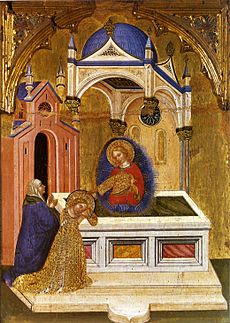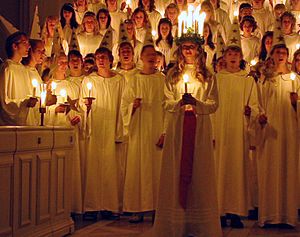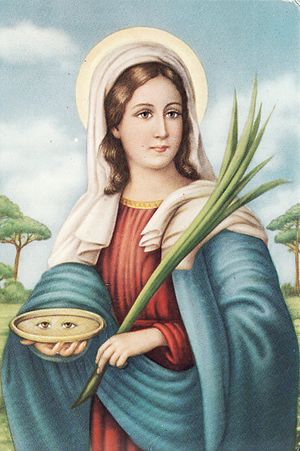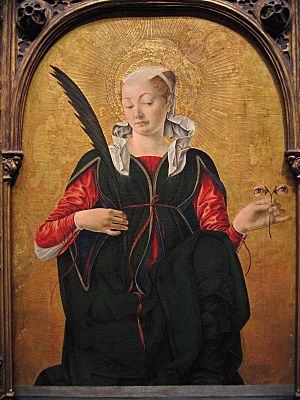Saint Lucy facts for kids
Quick facts for kids SaintLucy |
|
|---|---|
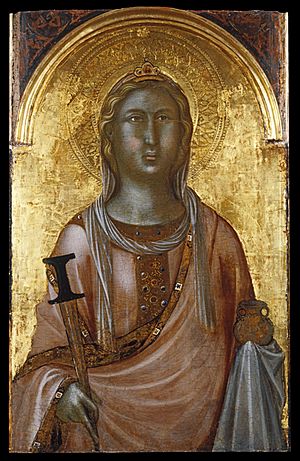
Saint Lucy, by Niccolò di Segna mid 14th-century Sienese painting, circa 1340. The saint holds the dagger or sword with which she was ultimately executed and the lamp, her attribute.
|
|
| Virgin and Martyr | |
| Born | c. 283 Syracuse, Roman Empire |
| Died | 304 Syracuse, Western Roman Empire |
| Venerated in | |
| Canonized | Pre-Congregation |
| Major shrine | San Geremia, Venice |
| Feast |
|
| Attributes | Cord; eyes; eyes on a dish; lamp; swords; woman hitched to a yoke of oxen; woman in the company of Saint Agatha, Saint Agnes of Rome, Saint Barbara, Saint Catherine of Alexandria, and Saint Thecla; woman kneeling before the tomb of Saint Agatha |
| Patronage | The blind; martyrs; Perugia, Italy; Mtarfa, Malta; epidemics; salesmen; Syracuse, Italy; throat infections; writers; Sasmuan, Pampanga Philippines |
Saint Lucy (also known as Lucia of Syracuse) was a young Christian woman who lived in Syracuse, Sicily, during the Roman Empire. She was born around 283 AD and died in 304 AD. Lucy is honored as a saint in many Christian churches, including the Catholic Church, Anglican, Lutheran, and Eastern Orthodox churches. Her special day, called Saint Lucy's Day, is celebrated on December 13th. She is one of the most famous virgin martyrs, like Agatha of Sicily and Catherine of Alexandria.
Contents
Who Was Saint Lucy?
Lucy was born into a rich and noble family in 283 AD. Her father, who was Roman, passed away when she was only five years old. This left Lucy and her mother, Eutychia, without a father figure. Eutychia's name suggests she might have been from a Greek family.
Lucy's Mother and Her Illness
Lucy's mother, Eutychia, suffered from a serious bleeding illness. She worried about Lucy's future and arranged for her to marry a wealthy pagan man.
Fifty-two years before Lucy's time, another saint, Agatha of Sicily, had died for her faith. Saint Agatha's shrine in Catania, not far from Syracuse, was a popular place for pilgrims. Many people reported that miracles happened there. Eutychia was convinced to visit Catania, hoping to be cured.
A Dream and a Promise
While in Catania, Lucy had a dream. Saint Agatha appeared to her and told her that because of Lucy's strong faith, her mother would be healed. Saint Agatha also said that Lucy would become famous in Syracuse, just as Agatha was in Catania.
When her mother was cured, Lucy asked her to let her give away a large part of their wealth to the poor. Eutychia thought it would be better to leave the money in her will. But Lucy explained that it's better to give while you are healthy, rather than waiting until you can't take your riches with you.
Lucy's Brave Stand
News that Lucy was giving away her family's money and jewels reached her fiancé. He was very angry and reported her to Paschasius, the Governor of Syracuse. Paschasius ordered Lucy to offer a sacrifice to the emperor's statue. This was a common test for Christians at the time.
Lucy refused to do it. Because of her refusal, Paschasius sentenced her to be harmed.
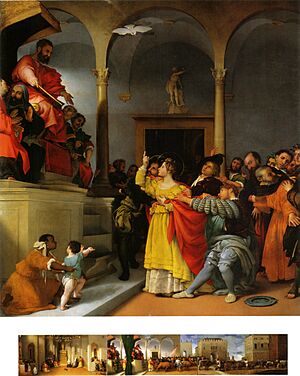
Christian stories say that when guards tried to take her away, they couldn't move her. Even when they tied her to a team of oxen, she wouldn't budge. Then, they piled wood around her and set it on fire, but the fire wouldn't burn her. Finally, she was killed with a sword.
The Story of Her Eyes
Later stories add more details. Before Lucy died, she supposedly predicted that Paschasius would be punished and that the persecution of Christians would soon end. She also said that the emperors would no longer rule. This made Paschasius so angry that he ordered her eyes to be removed.
Another version of the story says that Lucy took out her own eyes to stop a man who kept bothering her because he admired her beautiful eyes. However, when her body was being prepared for burial, it was discovered that her eyes had been miraculously restored. This is one reason why Saint Lucy is known as the patron saint of people with eye problems.
Honoring Saint Lucy
By the 500s, stories about Saint Lucy were well-known. Her popularity spread to England, where her feast day was celebrated until the Protestant Reformation.
Feast Day and Traditions
Saint Lucy's feast day is on December 13th. This day used to be the shortest day of the year (the Winter Solstice) before calendar changes. Because of this, her feast day became a festival of light, especially in countries with long, dark winters.
In Scandinavian countries like Sweden, Denmark, and Norway, girls dress up as Lucy. They wear a white dress, a red sash (symbolizing martyrdom), and a crown of candles on their heads. They carry special buns called St. Lucia buns in a procession and sing songs. People believe that celebrating Saint Lucy's Day helps them get through the long, dark winter days with enough light.
In Syracuse, Sicily, Italy, where Lucy was from, a silver statue of Saint Lucy containing some of her relics is paraded through the streets on December 13th. Sicilians remember a story that a famine ended on her feast day when ships full of grain arrived in the harbor. Because of this, it's traditional to eat whole grains instead of bread on December 13th. A popular dish is cuccìa, made of boiled wheat berries, often mixed with ricotta cheese and honey.
In some parts of Northern Italy, Saint Lucy is said to bring gifts to children between December 12th and 13th. Children often leave hay outside for Lucy's donkey and food inside for Lucy herself, to help them after their long night of delivering gifts.
In the Philippines, many villages celebrate Saint Lucy's Day with special prayers and processions. People sing hymns and attend Mass.
What Saint Lucy Represents
Lucy's Latin name, Lucia, comes from the Latin word lux, which means "light." This is why many traditions connect Saint Lucy with bringing light into the darkness of winter.
Patronage and Symbols
Because of the stories about her eyes, Saint Lucy is the patron saint of the blind. She is also the patron saint of writers, salesmen, and people who work with glass. She is asked for help with eye problems and throat infections.
In art, Saint Lucy is often shown holding a dish with two eyes on it. This represents her role as a protector of sight. She also holds a palm branch, which is a symbol of martyrdom and victory. Other symbols include a lamp, a dagger, a sword, or two oxen.
The Caribbean island of Saint Lucia is named after her.
Saint Lucy in Literature
Dante Alighieri's Divine Comedy
Saint Lucy appears in Dante Alighieri's famous poem, The Divine Comedy.
- In Inferno, she is a messenger sent to Beatrice (another important character) from the Virgin Mary. Lucy tells Beatrice to send the poet Virgil to help Dante. She represents "illuminating grace," guiding Dante out of darkness.
- In Purgatorio, Lucy carries a sleeping Dante to the entrance of purgatory. Again, she helps him move from darkness to light, both literally and figuratively.
- In Paradiso, Dante places Lucy in a special spot in the "Mystic Rose," showing her importance.
John Donne's Poem
In the Late Middle Ages, Saint Lucy's feast day often fell on the shortest day of the year. The poet John Donne wrote a poem called "A Nocturnal upon St. Lucie's Day, being the shortest day" (1627). The poem begins with the line: "'Tis the year's midnight, and it is the day's."
Places Named After Saint Lucy
Many places around the world are named in honor of Saint Lucy.
Churches
- Saint Lucy's Church in Syracuse, Sicily, Italy
- St. Lucia's Cathedral in Kotahena, Sri Lanka
- Church of San Geremia and the grave of Saint Lucy in Venice, Italy
- St. Lucy Catholic Church in Highland Beach, Florida, United States
- Sta. Lucia Parish in Sasmuan, Pampanga, Philippines
Other Places
- St. Lucia, a country in the Caribbean
- Port St. Lucie, Florida, United States
- Santa Lucia, Ilocos Sur, Philippines
- Santa Lucia Mountains, California, United States
- Venezia Santa Lucia railway station, Venice, Italy
Images for kids
See also
 In Spanish: Lucía de Siracusa para niños
In Spanish: Lucía de Siracusa para niños
- List of Christian women of the patristic age
- List of Eastern Orthodox saints
- List of Roman Catholic saints
- Saint Odile, another saint of the blind.


